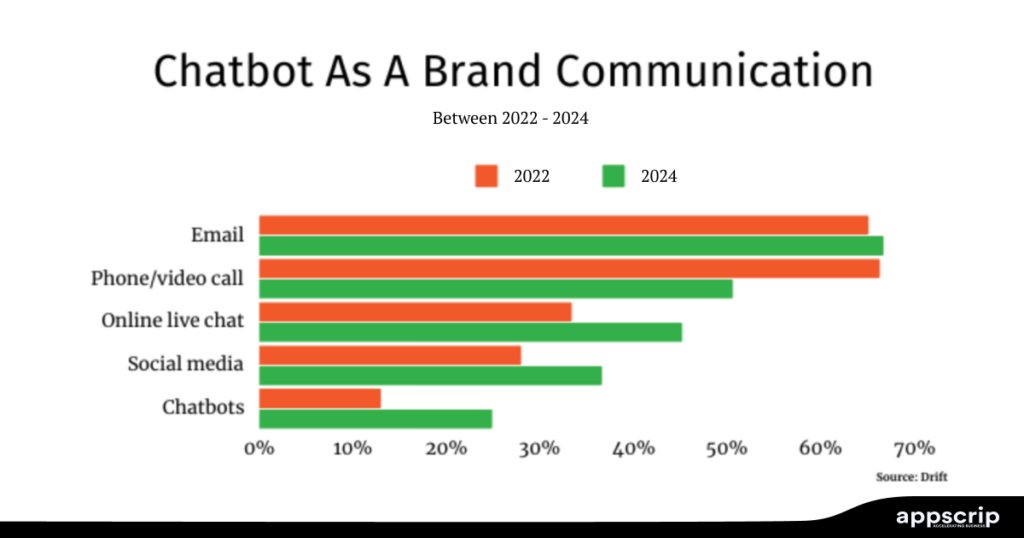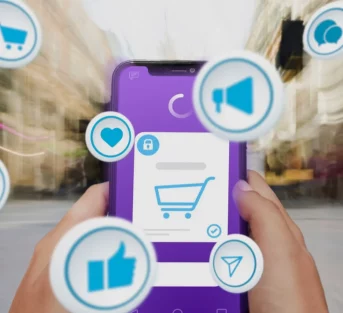The Salsify report on consumer shopping habits discovered that buyers research at least 11 different sources before making a purchase. Thus a multichannel approach is the ideal route for ecommerce businesses to keep up with their customers and meet their demands.
And to keep up with customer conversations across multiple channels, AI chatbots is just the panacea that ecommerce businesses need.
Integrating AI chatbots for ecommerce across websites, mobile apps, and social media, creates an omnichannel experience. And to top it off, Chatbots are easily scalable, handling thousands of queries a day while enhancing operational efficiency.
Why Chatbot Adoption in E-commerce Is Vital
The Tidio found that the total cost savings reaped by deploying chatbots touched $11 billion in 2022, and customer support costs too reduced.
- By 2025, 85% of customer interactions in e-commerce will be handled by chatbots. (Gartner)
- 60% of consumers prefer chatbots for the instant responses they elicit.
- Businesses can save up to 30% in operational costs using chatbots for customer service.
- E-commerce platforms with chatbots will experience a 15—35% increase in conversion rates. (Juniper Research)
Types of Chatbots
Chatbots kicked off as a simple customer service tool that answered predefined questions users posed. But now thanks to AI and ML, chatbot now automates interactions, provides instant customer support, and drives sales.
While their main intent is on enhancing automation, chatbots can be broadly categorized into three main types. Here’s an overview:
1. Simple Chatbots
Simple chatbots are the most basic type and work on the rule-based principle. These chatbots are ideal for straightforward interactions only.
How They Work:
Simple chatbots follow a decision-tree model, where users are presented with predefined options with only 2 possible responses. Simple chatbots do not learn from past conversations and the conversation advances based on the user’s input.
Examples
- Order Tracking for E-commerce: To track an ecommerce order, the user is asked to input the order number. The chatbot then provides either a status update or a tracking link and completes the interaction.
- Appointment Scheduling for Salons: Chatbots guide users through the variety of services available at a salon and the free-slots open for an appointment. The user can now go ahead and book for the services they need, and then confirm the time of the appointment as well.
- Basic FAQs for Customer Support: A simple chatbot answers straightforward queries like “What are your business hours?” or “What is the process to return a product?”
Limitations:
Simple chatbots are not built to answer or process complex queries. They also do not have the ability to infer the user’s intent. Simple chatbots are built for routine, structured tasks only, thereby limiting their usability.

2. Smart Chatbots
Smart chatbots can handle more functions than the rule-based simple chatbots. It utilizes AI and natural language processing (NLP) to understand user intent, interpret the context, and analyse the sentiment of the user.
How They Work:
Smart chatbots work using conversational AI. User requests are processed and interpreted by a smart chatbot to provide relevant responses. Smart chatbots also improve over time by learning from earlier interactions making them ideal for reliable customer engagement.
Examples
- Product Recommendations in E-commerce: When a user is looking for a product keys in, “Can you suggest an eco-friendly skincare product,”. The chatbot then suggests products based on the user’s preferences, past purchases, and inventory available.
- Customer Support in Telecom: Smart chatbots are built to process open-ended queries like, “My smartphone isn’t connecting to the internet,”. The chatbot can infer the request and offer tips to troubleshoot. But if the user does not seem to be satisfied with the response or the issue is not resolved, it may escalate the issue to a human agent.
- Travel Assistants: Chatbots like Hopper can understand and infer phrases like, “Can you find me the cheapest flights to SFO next month,”. The smart chatbot then goes about providing the necessary information.
Advantages:
Smart chatbots are capable of producing human-like conversations. They can also fathom and process complex requests thus ensuring a satisfying user experience.
3. Hybrid Chatbots
Hybrid chatbots, as the name suggests combines the capabilities of rule-based and smart chatbots. This gives businesses the ability to address both simple and complex customer requests on a need basis.
Hybrid chatbots have the ability to interpret the user context. Hybrid chatbots have adopted structured workflows – that is a series of sequential questions, and the response for each step creates a clear path to a solution, making them highly versatile.
How They Work:
Hybrid chatbots are built with the capability to handle both the predefined tasks with rule-based responses as well as use conversational AI for more complex queries. This dual proficiency allows them to handle diverse customer queries on-need basis efficiently.
Use Cases:
- Food Delivery Services: Hybrid chatbots are typically used by restaurants for receiving food orders. While placing an order, clients may have specific requests like – Make the dish spicy or add more olives. Such requests can be handled by hybrid chatbots easily.
- Retail Product Customization: A clothing store chatbot could suggest items that can go along with goods purchased. This could be based on customer preferences to complement the ensemble. Or they can even assist with size or colour as per the customer request.
- Healthcare Assistance: A hybrid chatbot can guide patients based on symptoms described to either schedule an appointment at the nearest health clinic. Or in case of an emergency to seek help quickly and visit the ER.
Benefits:
Hybrid chatbots are adept at ensuring a balance between responding to simple queries or even resolving complex and sophisticated requests. This makes them a pragmatic choice for businesses that cater to customer interactions that are varied and where the chatbot needs to infer intent and emotions as well.
Finally choosing a chatbot for your business requirements depends on your goals, the needs of the customer, and the complexity of tasks you are automating.

How AI Chatbots Enhance E-commerce
Chatbots are turning out to be priceless tools for the ecommerce industry due to features such as real-time customer support, product recommendations, guide to checkout, clearing queries instantly, and reducing cart abandonment.
This leads to increased conversion and improved customer engagement. We take up the top reasons on why ecommerce businesses must ideally adopt chatbots.
Streamlined Customer Support
24/7 Availability
The universal advantage offered by chatbots is round-the-clock availability. Now they can even address customer queries instantly, regardless of time constraints or the season. This boosts customer satisfaction and cuts cart abandonment rates due to unresolved concerns.
Chatbots also handle high volumes of traffic, eliminating wait times and providing a positive user experience.
Handling Common Queries and Escalation to Human Agents
- Automated responses: Chatbots efficiently manage repetitive tasks, such as tracking orders, processing refunds, or providing store hours.
- Easy escalation: When issues are complex, chatbots transfer conversations to human agents maintaining continuity.
Escalation Of Customer Queries
Handling Common Queries or Escalation:
- Chatbots are good at handling repetitive queries, such as refund policies, order tracking, or product information. If a customer raises a complex query, chatbots escalate the conversation to human agents. This ensures that the user receives the much needed assistance and timely resolution
Customer Engagement
How Chatbots Offer a Conversational Interface:
With natural language processing (NLP) AI chatbots can carry out human-like conversations by inferring intent. This makes interactions real, personal and engaging. Understanding customer needs and preferences are by far the best resolution that can be accorded as the chatbot guides users to relevant products or solutions.
How Chatbots Guide Customers Through Checkout:
- Among the top instances of assistance to customers is the simplification of the checkout process, with step-by-step guidance, moving items to the cart to complete the payment. Chatbots can also offer discounts, clear last-minute doubts, or suggest complementary products, reducing cart abandonment and ensuring a sale

Personalised Recommendations
How Chatbots Use Data to Provide Tailored Suggestions
The most prevalent application of AI chatbots is to provide customers with personalised recommendations. By using advanced algorithms, customer behaviour, and purchase history, customer preferences are deduced to come up with relevant suggestions. By processing vast amounts of data, chatbots recommend products that would most likely interest a customer. For example:
- The system could identify a returning customer and present them with suggestions for products that could add value to their past purchases.
- Depending on the seasonal or trending products, like winter usage skin-care products. Customers could receive recommendations and offers in line with climatic conditions or location based products.
Improved Conversions
Guided Cross-Selling and Upselling Techniques
Chatbots are very much similar to virtual sales assistants. They guide customers through the purchasing process by:
- Enquiring apt questions to know their preferences.
- They can instantly reel out product features and benefits.
- They can even suggest higher-value alternatives (upselling) or encourage buyers to invest in complementary products (cross-selling).
Reducing Cart Abandonment Rates with Chatbot Assistance
- Proactive reminders: Notifications and offers are served to customers who abandon carts leaving items in it.
- Addressing concerns: Queries on pricing, shipping, or product details are resolved without delay to complete a sale.
- Personalized discounts: On certain occasions depending on the inventory, discounts or free shipping are proffered to complete a sale.
Data Collection, Lead Generation, and Analysis
How Chatbots Qualify Potential Leads:
Chatbots also make it possible to identify your bottom-funnel. Chatbots interact with users to gather information regarding preferences, budget, and specific needs. This helps in sourcing leads, subdividing customers and guiding the sales team.
How Chatbots Gather Valuable Data:
AI chatbots eavesdrop conversations to collect valuable information. With this information behaviour patterns, FAQs, and preferences can be worked out. This data is further analysed to improve their product offerings, marketing strategies, and customer service.
Top 6 AI Chatbots for Ecommerce
AI chatbots are revolutionizing the e-commerce industry by enhancing customer engagement, streamlining processes, and driving sales. Below, we delve into the top 6 AI chatbots:
1. Appscrip
Appscrip offers a comprehensive solution for creating custom AI chatbots suited to e-commerce applications. Our custom AI chatbots can be customised to include features such as NLP, automated responses, user behaviour tracking, and integration with analytics tools.
Our platform offers advantages such as:
- Scalability: To efficiently manage numerous AI agents on a single platform.
- Full Power Control: You are provided with detailed reports, access management, and can monitor token consumption.
- Human-AI Collaboration: Seamless workflows are made possible between AI agents and human team members.
- Dynamic Data Handling: Challenges associated with frequently changing information are taken care of.
Key components include:
- Knowledge Management Module: Enterprise-specific knowledge is converted into AI-ready content, supporting data management, multi-language processing, and data cleansing.
- Accuracy Management Module: Ensuring AI agents deliver precise responses through search augmentation, validation systems, and automated testing.
- Integrations & APIs: Connecting to external systems via APIs, including integration for large action models and input/output connections.
- AI Performance Module: Monitoring and optimizing AI performance with caching management and performance tracking.
- Management & Reporting Module: Overseeing AI agents and analysing conversational data for insights, including analytics on usage and performance.
- Built-in Touchpoints: Supporting mainstream platforms like LINE, Facebook, WhatsApp, and offering solutions like voice bots for multi-language conversations and specialized kiosks for avatar AI.
Appscrip’s no-code platform enables even first time tech users to build and deploy custom AI chatbots. You can in fact customize the chatbot’s user interface, and gain valuable customer insights from interactions.
2. Tidio
Tidio is best designed for SMBs and among the top AI chatbots for ecommerce. There’s live chat, chatbots, and email marketing on a single interface. It proffers ease of use, affordability, and focuses specifically on e-commerce functionalities. Theirs is an intuitive drag-and-drop chatbot builder.
Features:
- You get a visual chatbot editor with pre-built templates.
- AI-powered chatbot responses with “Lyro” conversational AI.
- Integrations with Shopify, WooCommerce, WordPress, etc.
- Visitor tracking and analytics.
Pros:
- Easy to set up and use, even for non-technical users.
- Affordable pricing plans.
- Strong focus on e-commerce.
- Cuts cart abandonment with automated reminders.
Cons:
- Limited customization.
- AI capabilities still have a long way to go.
Pricing:
- Free Plan: Available with limited features.
- Paid Plans: Start at $29/month.
3. Drift
Drift is a conversational marketing platform with focus on lead generation and sales. AI-powered chatbots help qualify leads, schedule meetings, and personalize website experiences. Drift is suited for B2B e-commerce and businesses with high-value sales.
Features:
- Drift easily integrates with CRMs (Salesforce and HubSpot) and marketing tools.
- Advanced lead qualification and routing capabilities.
- AI-driven personalization to engage and convert visitors.
- Supports video and voice messaging within chat.
- Account-based marketing (ABM) features
Pros:
- Strong emphasis on sales and marketing automation.
- Advanced targeting and personalization capabilities.
- Good for B2B e-commerce and high-value sales.
- Increases lead quality by qualifying prospects in real-time.
Cons:
- Expensive when compared to other options available.
- Requires a detailed setup and configuration operate effectively.
Pricing:
Starts at $2,500 per month, providing 24/7 custom chatbots for customer assistance and conversion.

4. Zendesk Answer Bot
This AI chatbot for ecommerce is integrated with the Zendesk customer service platform helping businesses improve support functions and reduce agent workload. This is ideal for companies already using Zendesk.
Zendesk Answer Bot is a robust solution that complements Zendesk’s customer support suite, offering effective automation for common queries.
Features:
- Instant resolution for FAQs and support tickets.
- Automates support while maintaining human-agent integration.
- Omnichannel support across email, chat, and social media platforms.
- AI-powered suggestions for human agents to improve response efficiency.
- Integrates with Zendesk’s customer service platform.
- Suggests relevant help center articles to deflect tickets.
Pros:
- Easy integration with a widely used customer service platform.
- Effective at resolving common customer issues.
- Reduces support team workload by handling repetitive tasks.
- Multilingual support.
Cons:
- May require a Zendesk subscription.
- Customization options for the chatbot’s appearance and behaviour may be limited.
Pricing:
Starts at $495 per 1,000 tickets/chats, with feature-based usage tiers.
5. LivePerson
This enterprise-grade conversational AI platform is designed for large businesses. It offers a comprehensive suite of features, including AI-powered chatbots, live chat, omnichannel support, and robust analytics.
LivePerson focuses on providing personalized customer experiences at scale, handling complex inquiries, and improving operational efficiency. Its advanced AI capabilities and scalability make it a suitable choice for large e-commerce businesses.
LivePerson is among the leading AI chatbots for ecommerce businesses looking to offer conversational commerce experiences.
Features:
- AI-powered messaging across platforms like WhatsApp, SMS, and social media.
- Real-time analytics to optimize conversations and improve customer satisfaction.
- Advanced sentiment analysis to gauge customer emotions.
- Support for complex workflows like personalized product recommendations and guided shopping.
- Focus on enterprise-level solutions with advanced features.
- Omnichannel support across various messaging platforms.
Pros:
- Highly scalable and customizable for large businesses.
- Offers a wide range of features and integrations.
- Strong emphasis on AI and automation.
- Exceptional conversational commerce capabilities.
- Increases average order value (AOV) through tailored product suggestions.
Cons:
- Can be complex to set up and manage.
- More expensive than other options, targeted at larger enterprises.
Pricing:
LivePerson offers customized pricing based on specific business needs and scale.
6. HubSpot Chatbot
HubSpot Chatbot is part of the HubSpot CRM platform. It provides a user-friendly visual chatbot builder with templates for various use cases, including lead generation, customer support, and meeting scheduling.
The chatbot integrates seamlessly with HubSpot’s marketing, sales, and service tools, creating a unified platform for managing customer interactions. It’s a good choice for businesses already using HubSpot or those seeking a CRM-integrated chatbot solution to streamline their marketing and sales processes.
HubSpot’s chatbot is part of its comprehensive marketing, sales, and customer service platform, making it ideal for data-driven e-commerce businesses.
Features:
- Integration with HubSpot CRM for personalized customer interactions.
- Automation of lead qualification and nurturing processes.
- Built-in ticket creation for efficient customer support management.
- Drag-and-drop builder for easy customization.
- Visual chatbot builder with templates for various use cases.
- Integrates with HubSpot’s marketing, sales, and service tools.
- Live chat handoff to human agents.
Pros:
- Tight integration with a comprehensive CRM platform.
- Easy to use and get started with, especially for HubSpot users.
- Fully integrated with HubSpot’s marketing and sales tools for seamless data sharing.
- Enhances marketing efforts with AI-powered lead engagement.
Cons:
- Advanced features may require a paid HubSpot subscription.
- May not be as specialized for e-commerce as some other options.
Pricing:
Free Plan: With basic chatbot features.
Starter Plan: $18 per month (includes 2 paid users), offering additional features.
Professional Plan: $450 per month (includes 5 paid users), with advanced capabilities.
Bottom Line:
These top 5 AI chatbots each cater to unique e-commerce needs. Whether you’re a startup looking for cost-effective solutions (Tidio), an enterprise aiming to enhance customer support (Zendesk Answer Bot), or a business focused on conversational commerce (LivePerson), there’s a chatbot tailored for your goals.
Choosing the right platform depends on your business size, target audience, and operational priorities.

Challenges in Implementing AI Chatbots
The main challenges include: initial setup costs, understanding user intent, handling language complexities, integrating with existing systems or ecommerce systems can be complex and time consuming, maintaining data privacy and security while aiming to create a user experience that feels humane.
Compatibility issues may arise, leading to disruptions in operations or additional costs for system upgrades. However, Leveraging professional AI Integration Services can streamline the process and minimize potential challenges.
We detail the top 3 challenges:
Initial Setup and Costs
Investment in Technology and Integration
- Development costs: A significant investment is the first debacle while building an AI chatbot. This could be either for customizing an existing platform or building one from scratch.
- Integration challenges: The second debacle is ensuring compatibility with existing CRM systems, e-commerce platforms, and APIs.
- Training data requirements: For AI chatbots to perform at par, the need for extensive datasets is key, which can increase upfront costs.
Data Privacy and Security
Concerns Over Customer Data Usage
- Data breaches: The risk of cyberattacks cannot be overlooked, storing and processing sensitive customer information needs to be well-guarded.
- Compliance issues: Adhering to regulations like GDPR or CCPA is a must to avoid penalties and maintain customer trust.
- Transparency concerns: Be transparent on how customer data is used. Maintain explicit privacy policies.
Maintaining Natural Conversations
Limitations of AI in Understanding Complex Queries
- Contextual misunderstandings: When chatbots have not been properly vetted, they may struggle with ambiguous or complex questions.
- Language nuances: The human language has umpteen variations in phrasing, slang, or regional dialects that can confuse AI.
- Continuous training needs: The only route to improve language models and keep up with customer expectations is via regular updates.
ROI on AI Chatbots
Chatbots could cut costs by more than $8 billion per year by automating customer service programs using AI. Healthcare, e-commerce and banking, manage large volumes of human interaction, and should benefit most.
Cost Savings vs. Increased Revenue
Comparison of Manual and Automated Customer Support Costs
Cost of Manual Support:
Businesses with high volumes of inquiries find hiring, training, and retaining customer support staff a huge load on their budget.
Human agents can typically handle only one query at a time. This leads to longer wait time, slow response, customer dissatisfaction and fatigue, and increased operational costs.
Cost of Automated Support (AI Chatbots):
AI chatbots can operate 24/7 without break, this reduces labour costs drastically.
They can also handle multiple conversations simultaneously, ensuring scalability without additional investment.
Maintenance and updates to chatbot systems are much lower as compared to staffing costs.
Revenue Uplift Through Chatbots:
Upselling and Cross-Selling: Chatbots can offer personalised product recommendations easily as they have the required information, thus increasing average order values.
Cart Recovery: The ability to provide information helps chatbots to proactively address customer concerns or doubts about pricing, shipping, or product details reducing cart abandonment rates.
Customer Retention: Customers always seek quick response times, necessary information and a smooth check out. This improves their shopping experience, enhancing customer loyalty and encouraging revisits.
Metrics to Measure Success
1. Conversion Rates:
- Measure the number of chatbot interactions that lead to a sale or desired action. This could be to complete a sale, signing up for a newsletter or downloading an app.
- Upselling or cross-selling is a huge boost in revenue for most firms. Tracking upselling and cross-selling performance by chatbots is a good measure of their success.
2. Customer Satisfaction Scores (CSAT):
- Approaching users through post-interaction surveys to collect feedback helps understand the effectiveness of chatbots.
- Higher satisfaction scores -interacting with chatbots, usually refer to quick responses, accurate information, multi-lingual support, and personalised service provided by chatbots.
3. Customer Retention:
- Analyse the number of customers who made a repeat purchase after interacting with a chatbot as compared to the number of those who didn’t come back. This is a good indicator of customer retention aided by chatbots.
- Chatbots’ ability to quickly respond and address concerns promptly often lead to satisfaction, trust and brand loyalty.





